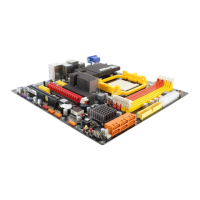
Do you have a question about the ECS A785GM-M and is the answer not in the manual?
| Number of memory slots | 4 |
|---|---|
| Maximum internal memory | 32 GB |
| Processor socket | Socket AM3 |
| Processor manufacturer | AMD |
| USB 2.0 connectors | 3 |
| Power fan connector | Yes |
| Number of COM connectors | 1 |
| Number of SATA connectors | 6 |
| Controller interface type | AMD SB710 |
| PS/2 ports quantity | 0 |
| eSATA ports quantity | 2 |
| USB 2.0 ports quantity | USB 2.0 ports have a data transmission speed of 480 Mbps, and are backwards compatible with USB 1.1 ports. You can connect all kinds of peripheral devices to them. |
| Audio chip | Realtek ALC888S |
| Power source type | ATX |
| Motherboard chipset | AMD 785G |
| Audio output channels | 7.1 channels |
| Motherboard form factor | micro ATX |
| BIOS type | AMI |
| RAID levels | 0, 1 |
| LAN controller | RealTek RTL8111D(L) |
Basic overview of the motherboard model and its target market.
Details key processor, chipset, and connectivity features of the motherboard.
Visual identification and labeling of motherboard hardware components.
Essential safety guidelines to prevent damage during installation.
Guidance on selecting a compatible and appropriately sized computer case.
Step-by-step instructions for physically mounting the motherboard inside a PC case.
Overview of the BIOS Setup Utility's purpose and functionality.
Configuration of basic system settings like date, time, and IDE/SATA devices.
Detailed system configuration options for performance and features.
Information on the contents of the support disc, including drivers and utilities.
Procedure for automatic installation of drivers and software from the disc.
Explanation and setup steps for enabling hybrid graphics functionality.
Initial BIOS configuration steps to enable RAID functionality.
Step-by-step guide to create and configure RAID arrays using AMD RAID BIOS.
Overview of the eJIFFY fast boot utility for quick access to basic functions.
Procedures for installing eJIFFY and enabling its activation in BIOS.
Solutions for common issues encountered during initial PC assembly and boot.
Troubleshooting tips for issues arising after the PC has been used for some time.
Basic maintenance guidelines to ensure the longevity and optimal performance of the motherboard.
